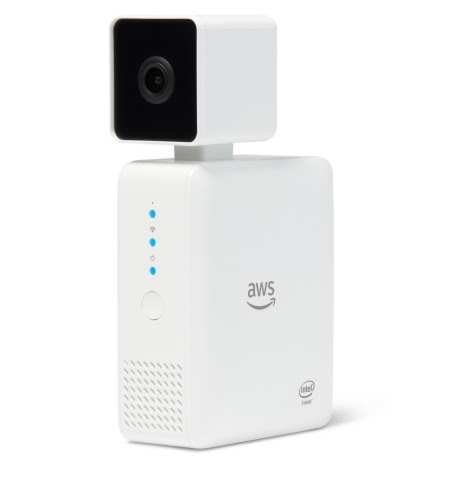| Amazon's Giant Push Into Machine Learning |
| Written by Sue Gee | |||
| Thursday, 30 November 2017 | |||
|
Amazon SageMaker, a fully managed service for the machine learning process; AWS DeepLens, a deep learning-enabled wireless video camera and four new machine learning application services were announced on the third day of this year's AWS re:Invent and are a direct challenge to Google and Microsoft. Until now when we've put Amazon and Machine Learning together in the same sentence it has generally been in the context of recommendation systems. Indeed, when Amazon Machine Learning was introduced at 2015's AWS re:Invent recommendations based on purchases was used as the main illustration. This has changed overnight with a range of new products and services announced by AWS CEO Andy Jassy. Now Amazon is poised to take advantage of its position as the leading cloud provider to penetrate areas of machine learning and artificial intelligence currently dominated by Microsoft and Google. Introducing SageMaker, Amazon uses a by now familiar refrain: Today, implementing machine learning is complex, involves a great deal of trial and error, and requires specialized skills. Developers and data scientists must first visualize, transform, and pre-process data to get it into a format that an algorithm can use to train a model. We know how it goes on - training models needs massive amounts of computer power and huge investment of time, a lot of effort and guesswork goes into each stage. Then deployment needs a different set of specialized skills. A fully managed service, SageMaker is Amazon's solution for eliminating the: "heavy lifting and guesswork from each step of the machine learning process"
It has three main components which can be used in isolation or as an end-to-end process:
Commenting on SageMaker, Swami Sivasubramanian, VP of Machine Learning, AWS, said: "Our original vision for AWS was to enable any individual in his or her dorm room or garage to have access to the same technology, tools, scale, and cost structure as the largest companies in the world. Our vision for machine learning is no different, we want all developers to be able to use machine learning much more expansively and successfully, irrespective of their machine learning skill level. Amazon SageMaker removes a lot of the muck and complexity involved in machine learning to allow developers to easily get started and become competent in building, training, and deploying models." Andy Jassy's introduction to SageMaker has more details:
Sivasubramanian also explained how the four new machine learning applications are a natural extension to AWS: "Today, customers are storing more data than ever before, using Amazon Simple Storage Service (Amazon S3) as their scalable, reliable, and secure data lake. These customers want to put this data to use for their organization and customers, and to do so they need easy-to-use tools and technologies to unlock the intelligence residing within this data. We're excited to deliver four new machine learning application services that will help developers immediately start creating a new generation of intelligent apps that can see, hear, speak, and interact with the world around them."
This final service builds on Amazon Rekognition for still images that was launched at last year's AWS re:Invent. At the same time Amazon Polly, a text-to-speech service and Amazon Lex which combines speech recognition and natural language understanding and powers Amazon Alexa were introduced. Back then I noted that these services seemed like a catch-up to those provided by Microsoft. However, with AWS having a more developed cloud ecosystem Amazon now seems to be making an overtaking move on Microsoft Cognitive Services. AWS DeepLens claims to to be the first of its kind: a deep-learning enabled, fully programmable video camera, designed to put deep learning into the hands of any developer, literally.
AWS DeepLens, which is available for pre-order and will ship in the US in April 2018, is priced at $249, the same as Google's wearable camera called Clips that debuted last month and uses machine learning to identify people and pets of your choosing and only capture them. Price is the only feature in common. AWS DeepLens is an HD video camera with on-board compute capable of running over 100 billion deep learning operations per second. It comes with sample projects, example code, and pre-trained models to allow developers with no machine learning experience to run their first deep learning model in less than ten minutes. For example, AWS DeepLens could be programmed to recognize the numbers on a license plate and trigger a home automation system to open a garage door, or AWS DeepLens could recognize when the dog is on the couch and send a text to its owner. AWS DeepLens integrates with Amazon SageMaker so that developers can train their models in the cloud with Amazon SageMaker and then deploy them to AWS DeepLens with just a few clicks in the AWS Management Console. Again, it is this cloud integration that could give Amazon an edge over its rivals and make it a prime player in AI.
More InformationRelated ArticlesAmazon Rekognition Can Now Estimate Your Age To be informed about new articles on I Programmer, sign up for our weekly newsletter, subscribe to the RSS feed and follow us on Twitter, Facebook or Linkedin.
Comments
or email your comment to: comments@i-programmer.info |
|||
| Last Updated ( Wednesday, 04 December 2019 ) |



